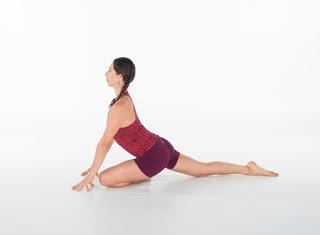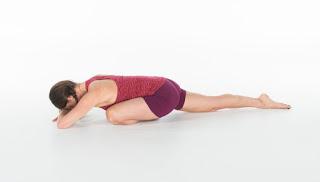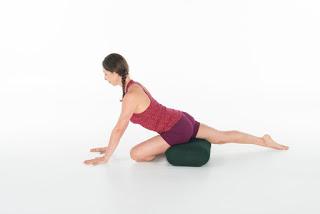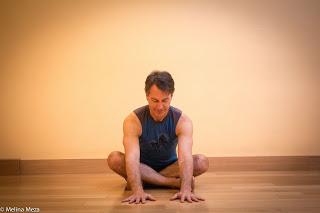A: Although I myself have not noticed these recent discussions, I certainly can understand the interest in this topic because Pigeon pose, which is really Eka Pada Rajakapotasana or One-Legged King Pigeon Pose, a modern yoga pose, is both ubiquitous in yoga classes and in often is used in advertising these days. (I will continue to refer to it as “Pigeon,” which is a nickname for the pose in question—another pose, Kapotasana, is actually Pigeon pose, but you now know the full name of the pose we’re talking about today). Pigeon pose seems particular popular with classes geared towards younger students and those interested in or more naturally adept at what many call “hip opening” poses. For those unfamiliar with the pose, the basic pose I have encountered in most classes usually has two versions. The first version, with the torso more upright, focuses more on the back bending of the spine and the stretch of the front of the back leg:
 The second version, in which you forward bend over the front leg, increases the stretching around the front hip:
The second version, in which you forward bend over the front leg, increases the stretching around the front hip:  If you are naturally flexible in the directions of movement this pose requires of the hips and spine, it is generally safe for your hip, knee, and lower back joints. And if you are stiffer in those areas, the pose may allow for gradual stretching of those tight areas, but I often recommend helpful propping in order for you to practice it safely as in this photo:
If you are naturally flexible in the directions of movement this pose requires of the hips and spine, it is generally safe for your hip, knee, and lower back joints. And if you are stiffer in those areas, the pose may allow for gradual stretching of those tight areas, but I often recommend helpful propping in order for you to practice it safely as in this photo:  The challenge and potential problem for older students practicing this pose is that they are more likely to have underlying conditions that would make this pose a potential risk for either aggravating on old issue or creating a new one. Several specific situations come to mind: osteoporosis of the spine or hips, hip and/or knee replacement, arthritis in the spine, hips, or knees, and history of general, non-specific low back pain, just to mention a few. I am particularly concerned with the way some teachers still recommend students position their front shin, parallel with the front of their mats. I consider this potentially dangerous for the ligaments and cushioning menisci of the front knee joint in students of all ages, which is one of the main reasons I rarely even teach this pose to my students any more. I am comfortable not teaching this pose because there are so many other poses that can address stiffness in the hips and spine, which create the same risk of injury and which are much more accessible to younger and older students alike. To improve spinal back bending ability, I recommend dynamic and static versions of low Cobra and Locust poses. For those who can’t get down to the ground easily, dynamic and static Arms Overhead Pose and dynamic and static versions of Warrior 1 pose are great alternatives, and the later also stretches the front of the back leg. Another good pose to stretch the front hip muscles and tissues is Lunge pose and all its variations. (see Featured Pose: Lunge Pose). Not pictured, but helpful for those who may be doing chair work only, is a chair version of Lunge, where you are sitting on the chair as you take the Lunge position. As for the stretch around the hip of the front leg in Pigeon, there are several good alternatives. Easy Sitting Pose with a forward bend is a good one:
The challenge and potential problem for older students practicing this pose is that they are more likely to have underlying conditions that would make this pose a potential risk for either aggravating on old issue or creating a new one. Several specific situations come to mind: osteoporosis of the spine or hips, hip and/or knee replacement, arthritis in the spine, hips, or knees, and history of general, non-specific low back pain, just to mention a few. I am particularly concerned with the way some teachers still recommend students position their front shin, parallel with the front of their mats. I consider this potentially dangerous for the ligaments and cushioning menisci of the front knee joint in students of all ages, which is one of the main reasons I rarely even teach this pose to my students any more. I am comfortable not teaching this pose because there are so many other poses that can address stiffness in the hips and spine, which create the same risk of injury and which are much more accessible to younger and older students alike. To improve spinal back bending ability, I recommend dynamic and static versions of low Cobra and Locust poses. For those who can’t get down to the ground easily, dynamic and static Arms Overhead Pose and dynamic and static versions of Warrior 1 pose are great alternatives, and the later also stretches the front of the back leg. Another good pose to stretch the front hip muscles and tissues is Lunge pose and all its variations. (see Featured Pose: Lunge Pose). Not pictured, but helpful for those who may be doing chair work only, is a chair version of Lunge, where you are sitting on the chair as you take the Lunge position. As for the stretch around the hip of the front leg in Pigeon, there are several good alternatives. Easy Sitting Pose with a forward bend is a good one:  Also good are Cobbler’s Pose with a forward bend and Thread the Needle pose, also called Figure 4 (see my video at www.youtube.com). You can also try what I call Upside Down Pigeon. To do this pose, start by lying on your back and taking your one leg into the top leg position of Thread the Needle pose. Keep your bottom leg stretched along the floor. Now hold onto your top leg with two hands and mindfully invite your shin towards your chest so the shape is similar to the second version of Pigeon shown above. You still need to be mindful of the top knee in this version, but unlike classic Pigeon, which directs a lot force from the weight of your upper body into your front knee joint, Easy Sitting Forward Bend, Cobblers Forward Bend, Thread the Needle and Upside Down Pigeon allow for more control of the force placed on the joint. And for those who can’t get down to the floor, you can do Thread the Needle sitting in a chair, with or without some forward bending. (see my video at www.youtube.com). So, could you teach Pigeon to your students as they age? Yes, but not without some risk of injury to the places highlighted here, which likely outweigh the benefits you might associate with the pose. So I therefore recommend substituting the alternative poses described above. Anyone else have other favorite alternatives to Pigeon? Subscribe to Yoga for Healthy Aging by Email ° Follow Yoga for Healthy Aging on Facebook and Twitter ° To order Yoga for Healthy Aging: A Guide to Lifelong Well-Being, go to Amazon, Shambhala, Indie Boundor your local bookstore.Follow Baxter Bell, MD on YouTube, Facebook, and Instagram. For upcoming workshops and retreats see Baxter's Workshops and for info on Baxter see baxterbell.com.
Also good are Cobbler’s Pose with a forward bend and Thread the Needle pose, also called Figure 4 (see my video at www.youtube.com). You can also try what I call Upside Down Pigeon. To do this pose, start by lying on your back and taking your one leg into the top leg position of Thread the Needle pose. Keep your bottom leg stretched along the floor. Now hold onto your top leg with two hands and mindfully invite your shin towards your chest so the shape is similar to the second version of Pigeon shown above. You still need to be mindful of the top knee in this version, but unlike classic Pigeon, which directs a lot force from the weight of your upper body into your front knee joint, Easy Sitting Forward Bend, Cobblers Forward Bend, Thread the Needle and Upside Down Pigeon allow for more control of the force placed on the joint. And for those who can’t get down to the floor, you can do Thread the Needle sitting in a chair, with or without some forward bending. (see my video at www.youtube.com). So, could you teach Pigeon to your students as they age? Yes, but not without some risk of injury to the places highlighted here, which likely outweigh the benefits you might associate with the pose. So I therefore recommend substituting the alternative poses described above. Anyone else have other favorite alternatives to Pigeon? Subscribe to Yoga for Healthy Aging by Email ° Follow Yoga for Healthy Aging on Facebook and Twitter ° To order Yoga for Healthy Aging: A Guide to Lifelong Well-Being, go to Amazon, Shambhala, Indie Boundor your local bookstore.Follow Baxter Bell, MD on YouTube, Facebook, and Instagram. For upcoming workshops and retreats see Baxter's Workshops and for info on Baxter see baxterbell.com. 
